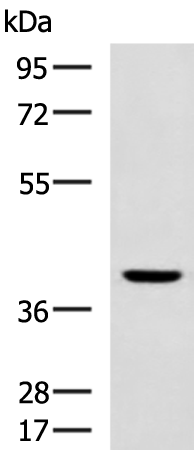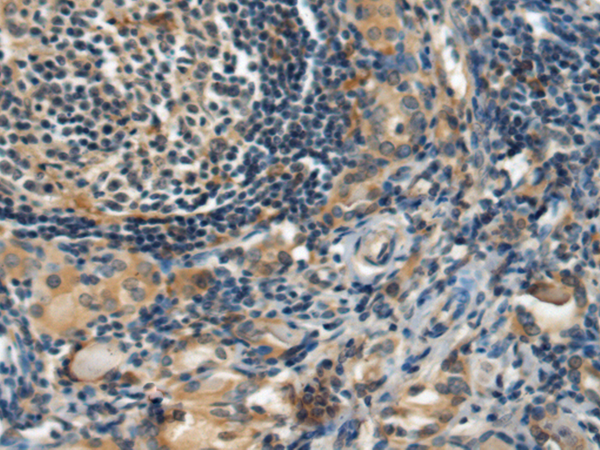


| WB | 咨询技术 | Human,Mouse,Rat |
| IF | 咨询技术 | Human,Mouse,Rat |
| IHC | 1/50-1/200 | Human,Mouse,Rat |
| ICC | 技术咨询 | Human,Mouse,Rat |
| FCM | 咨询技术 | Human,Mouse,Rat |
| Elisa | 1/5000-1/10000 | Human,Mouse,Rat |
| Aliases | SS-5-R |
| WB Predicted band size | 39 kDa |
| Host/Isotype | Rabbit IgG |
| Antibody Type | Primary antibody |
| Storage | Store at 4°C short term. Aliquot and store at -20°C long term. Avoid freeze/thaw cycles. |
| Species Reactivity | Human |
| Immunogen | Synthetic peptide of human SSTR5 |
| Formulation | Purified antibody in PBS with 0.05% sodium azide and 50% glycerol. |
+ +
目前我无法直接访问实时数据库或具体文献内容,以下为示例格式的模拟参考文献(非真实文献)。建议通过PubMed、Google Scholar等平台检索实际文献:
---
**示例1**
**文献名称**: "SSTR5 Antibody Development for Neuroendocrine Tumor Targeting"
**作者**: Smith A, et al.
**摘要**: 研究开发了一种高特异性SSTR5单克隆抗体,通过免疫组化验证其在胃肠胰神经内分泌肿瘤中的高表达,提示其作为靶向治疗载体的潜力。
---
**示例2**
**文献名称**: "Comparative Analysis of SSTR5 Antibody Specificity in Pituitary Adenomas"
**作者**: Zhang L, et al.
**摘要**: 对比了多种市售SSTR5抗体在垂体腺瘤组织中的染色特异性,发现克隆号XX的抗体灵敏度最高,为临床诊断提供参考标准。
---
**示例3**
**文献名称**: "SSTR5 Antibody-Conjugated Nanoparticles for Targeted Drug Delivery"
**作者**: Patel R, et al.
**摘要**: 构建了SSTR5抗体偶联的纳米颗粒,体外实验显示其可特异性结合SSTR5阳性肿瘤细胞并增强化疗药物递送效率。
---
**检索建议**:
1. 在PubMed中使用关键词:**SSTR5 antibody AND (neuroendocrine tumor OR imaging)**
2. 关注期刊:*Endocrine-Related Cancer*, *Molecular Pharmaceutics*
3. 常用抗体品牌:如Abcam、Santa Cruz的产品文献(官网Technical Documents版块)
Somatostatin receptor subtype 5 (SSTR5) is a G protein-coupled receptor (GPCR) that binds somatostatin and its analogs, playing a key role in regulating hormone secretion, cell proliferation, and neurotransmission. It is one of five SSTR subtypes (SSTR1-5) with distinct tissue distributions and signaling pathways. SSTR5 is prominently expressed in neuroendocrine tissues, the pituitary gland, pancreas, and certain cancers, including neuroendocrine tumors (NETs), breast cancer, and prostate cancer.
SSTR5 antibodies are immunological tools designed to detect and quantify SSTR5 expression in research and diagnostics. They are widely used in techniques like immunohistochemistry (IHC), Western blotting, and flow cytometry to study SSTR5's role in disease mechanisms, particularly in tumors that overexpress this receptor. Clinically, SSTR5 is a therapeutic target; its antibodies aid in identifying patients eligible for somatostatin analog therapies (e.g., octreotide) or peptide receptor radionuclide therapy (PRRT).
Research on SSTR5 antibodies also explores their utility in understanding receptor internalization, dimerization, and cross-talk with other signaling pathways. Challenges include ensuring antibody specificity due to structural similarities among SSTR subtypes. Recent advances in monoclonal antibody development have improved targeting precision, supporting both basic research and translational applications in oncology and endocrinology.
×